The conversation is not going the way I wanted.
“And why should I give the keys of the building terrace to you?”
“We want to see the art painted on the terrace of your building?”
“The terrace is not safe. You could fall over.”
“We’ll be very careful. We only want to see the art work there.”
“That is what everyone says.” The office bearer of the Nabi Nagar Co-op. Housing Society at Dharavi (Mumbai) glares at my friends and me and launches into a tirade about people pestering him for keys to the terrace all the time, how it was no longer safe for the building children as they wanted to go to the terrace, how it was a nuisance, etc.
We listen to him and commiserate with him and promise to be very careful and not allow any children up on the terrace with us. But he isn’t done ranting and after what seemed like a long time, he runs out of steam and grudgingly hands over the keys to us.
As we thank him, he says with a sly smile, “The lift doesn’t work. You’ll have to take the stairs all the way up to the terrace on the 9th floor.”

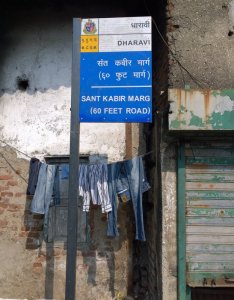 Dharavi was the second location chosen by the St+art India Foundation for St+Art Mumbai 2014 (7-30 November) festival, wherein 20 renowned street artists from India and abroad showcased their work. While I had seen the art work at Bandra, the other location, as part of a curated walk in November last year, I was able to visit Dharavi only earlier this year.
Dharavi was the second location chosen by the St+art India Foundation for St+Art Mumbai 2014 (7-30 November) festival, wherein 20 renowned street artists from India and abroad showcased their work. While I had seen the art work at Bandra, the other location, as part of a curated walk in November last year, I was able to visit Dharavi only earlier this year.
It was a warm afternoon in March when we turned into the 60 Feet Road of Dharavi. This long and winding road cuts through the area, connecting Mahim and Sion. This was my first time in Dharavi, in the sense that though I had passed through Dharavi umpteen number of times, this was the first time I am actually visiting it.
At that time of the afternoon, the traffic wasn’t too heavy and it was possible to look around for the art work instead of keeping an eye out for traffic. We walked past scrap shops, tea stalls, roadside shrines, cycle repair shops… with no sign of any art. At an intersection, a tour group made up entirely of international tourists crossed us and I visibly winced when the tour guide spoke about the “Jai Ho” spirit of Dharavi to them.
 The first of the murals we saw was on the terrace of a multi-storied building, their colours clearly visible through the haze. Painted on the water tanks of the building, the comparative freshness of the colours were in stark contrast to the grimy, exteriors of the building.
The first of the murals we saw was on the terrace of a multi-storied building, their colours clearly visible through the haze. Painted on the water tanks of the building, the comparative freshness of the colours were in stark contrast to the grimy, exteriors of the building.
Then we saw the next one, a large mural spanning three storeys — that of a woman with a crow — on the façade of the Sri Markandeya Coop. Housing Society. The colours of this stunning mural were such that it stood out and yet, blended in beautifully with the background and surroundings.

We tried to gain access to go to the terrace to see the art work on the water tanks, but did not succeed. Instead, we were directed to go across the street to Nabi Nagar Co-op. Housing Society, whose terrace supposedly had art as well. Initially, we were not too sure if we were being given the right information as we couldn’t see anything from the ground below. It didn’t help that some people said with conviction that there was nothing on the terrace and some other people said with equal conviction that there was art work ! We took a chance, and as I narrated at the beginning of this post, were lucky to get the keys this time.
We huffed and puffed our way up to the building’s terrace to find out that not only did it have some works of art, it also had a fantastic view of the area. Thanks to my camera’s zoom lens, I could even see the art painted on the water tanks of the building opposite !
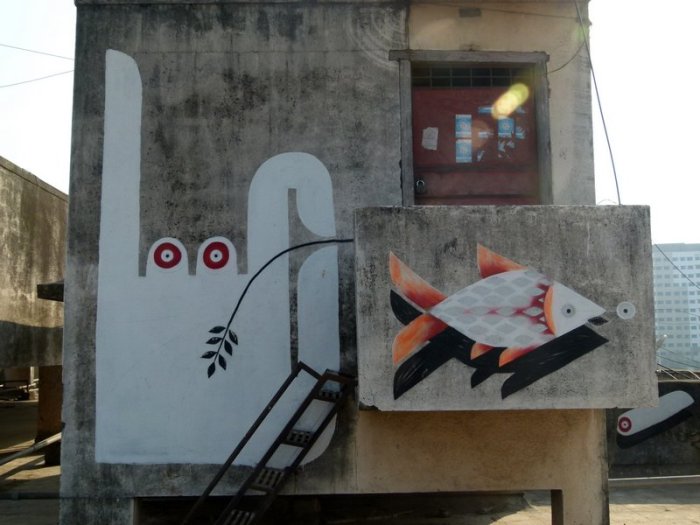
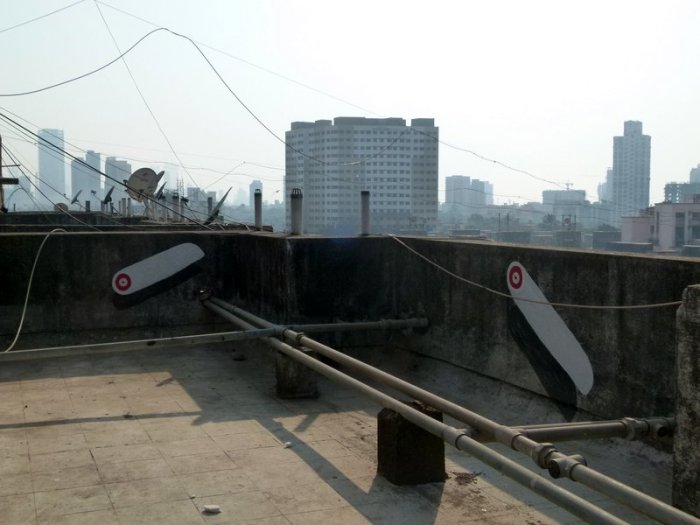
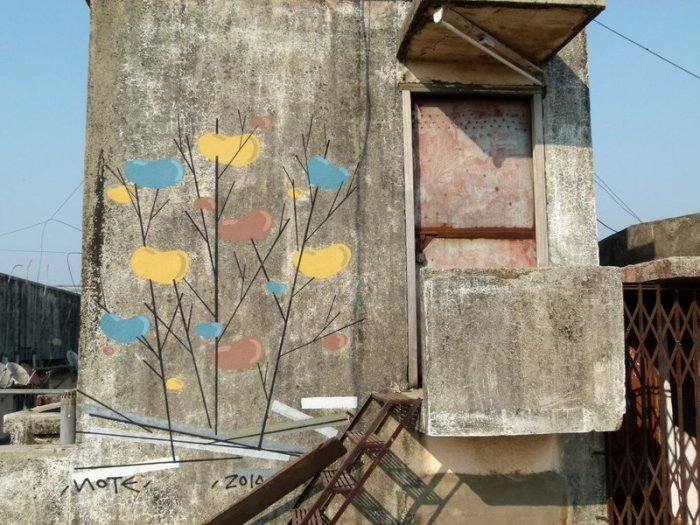


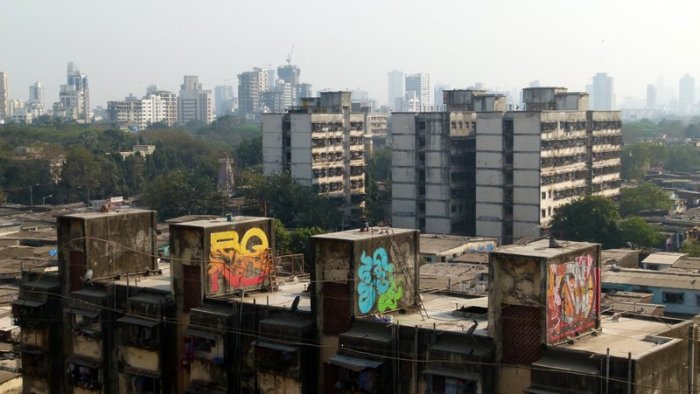
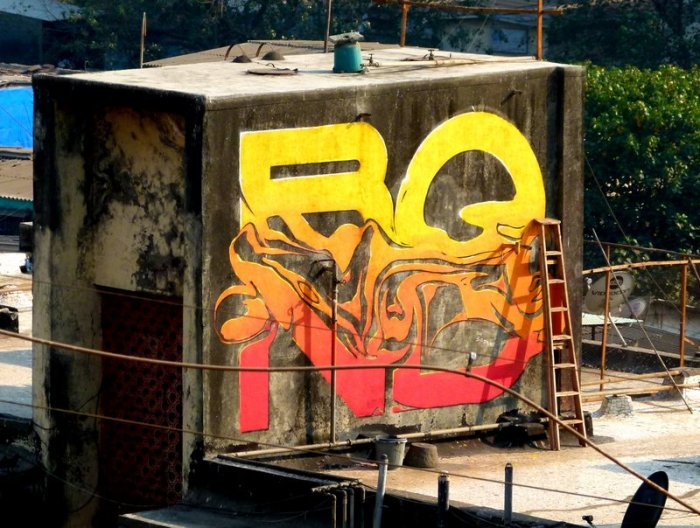

 From where I was standing, Dharavi stretched out below me in densely packed dwellings pierced by multi-storied buildings in all directions. It was easy to see and understand why Dharavi was considered to be among the densest clusters in India (and perhaps the world as well).
From where I was standing, Dharavi stretched out below me in densely packed dwellings pierced by multi-storied buildings in all directions. It was easy to see and understand why Dharavi was considered to be among the densest clusters in India (and perhaps the world as well).
Dharavi’s claims of being the entrepreneurial hub of Mumbai may be true; but so are its poor socio-economic indicators. While I did not see any visible poverty in my walk down the 60 ft road, I could sense it in the grim looks of people, in the snatches of conversations I heard, in the little roads leading away from the road and into shanties… it was a glimpse, but it was enough. The tragedy of a place like Dharavi is that it is either romanticised (like conducted slum tours) or it is wished away and ignored by civic authorities and residents.
The multi-storied buildings, built as part of the redevelopment plan for the area, look depressing with their grimy and discoloured facades and airless layout. I could barely see any green in the concrete and brick jungle below me ! The St+Art may have looked bright and fresh when they were first painted, but are no longer appealing. For the residents too, the novelty of having something to brighten up their surroundings appeared to have worn off. 😦
Normally, art cheers me up and is a mood lifter. But in Dharavi, it set me off with a lot of questions about the purpose of art and its relevance in place like this. About Dharavi itself and its people… Lots to think about there.
More Street Art from Mumbai: The writing on the wall | Nagrana Lane’s secrets | Bollywood on the walls | A fantasy world at Chapel Road | The St+art invasion of Bandra and a curated walk | Street art @ Reay Road
Join me on Twitter, Facebook and Instagram as I explore the world around me and share “My Favourite Things” with you.

Interesting stuff! Quite daringbaaz to go in Dharavi, you are!
LikeLiked by 1 person
Why daringbaaz? I agree that Dharavi has quite a reputation, but it is as safe as any other place in Mumbai.
LikeLike
Simply beautiful. Who knew such lovely colors were hidden in Dharavi’s mess!
LikeLiked by 1 person
Yes, who knew? But Dharavi always leaves me conflicted and restless as well.
LikeLike
It gives a new attitude to these otherwise horrible looking structures…
LikeLiked by 1 person
That’s one way of looking at it. Another way is to also draw attention to the terrible conditions of Dharavi. Kind of like Half-full or half empty way of looking at things.
LikeLike
Missed this 😦 Thanks for sharing.
LikeLiked by 1 person
You’re welcome, Deepak. I passed by this road the other day and the murals are still clearly visible. You can still see them. 🙂
LikeLike
The art is beautiful. But the surroundings are depressing. The art should be a change factor to the people.
LikeLiked by 1 person
Change rarely happens overnight or even quickly. I hope that this art is transformative is is the beginning of a movement.
LikeLiked by 1 person
Dharavi has always had attitude and not just for its ‘Jai Ho’. Great post.
LikeLiked by 1 person
Thanks, Srinayan. We’ve always known that Dharavi had attitude. The “Jai Ho” is a Western construct, don’t we?
LikeLike
I think I understand your sentiments here Sudha. Dharavi has often been romanticized for the wrong reasons. A slum tour is fine, but does that translate to the slum being cursed to remain exactly that for eternity to keep the tourists coming? Does this reflect on our incapability to make a novelty like Dharavi a cleaner, better planned and well managed community place, or does it show that we want to keep Dharavi intact with all the ‘slum experience’ even if it’s a challenge for the residents? I’m pondering this as much as you are.
On the other hand, the art is exceptional. Each one is very well made. I like the woman and the crow and those geometrical patterns. Wish it wasn’t a one time event but a monthly, quarterly activity encouraging residents of the area or children to paint their homes red, blue and ochre and show the world how an ill famed Dharavi can transform to one of the biggest street art gallery in the world.
LikeLiked by 1 person
The website of one of the slum tour operators in Dharavi has a page which gives a list of their guides. Only one of the guides is a resident of Dharavi and he clearly mentions that he is saving to earn enough to move out of Dharavi. Is the irony lost on the tour operators and the people who take such tours.
Dharavi is also home to many NGOs and self-help groups. I can’t help wondering why this hasn’t transformed to something better for the community. The multi-storied buildings that you see in the pictures replaced the slums there. While climbing up to the terrace, I had a chance to look at some of them – they are dark, dank and poorly ventilated. It makes me wonder if the people were better off in a slum housing ! There are only plans for buildings, buildings and more buildings. There is no talk of parks, open spaces, community spaces…
Coming to the art, I admit that I wouldn’t have visited Dharavi if not for the art. I had no reason to do so previously and slum tours are really not my thing. And yet the art that brought me her, which is breathtaking, also adds to the conflicting thoughts I have about the place.
LikeLike
Wow, these paintings make these lifeless buildings look so beautiful :).
LikeLiked by 1 person
Welcome to my blog, Tinkerswan. Thank you so much for stopping by and commenting.
LikeLiked by 1 person
Quite a lot to think about… appreciate your sharing and providing others a glimpse…
LikeLiked by 1 person
The paintings give a very strong flavour to the areas depicted in your photos. Can one blame if these areas are so highly romanticized then? Albeit I agree for all wrong reasons but your post makes me want to take the next bus to Mumbai and visit these myself..
LikeLiked by 1 person